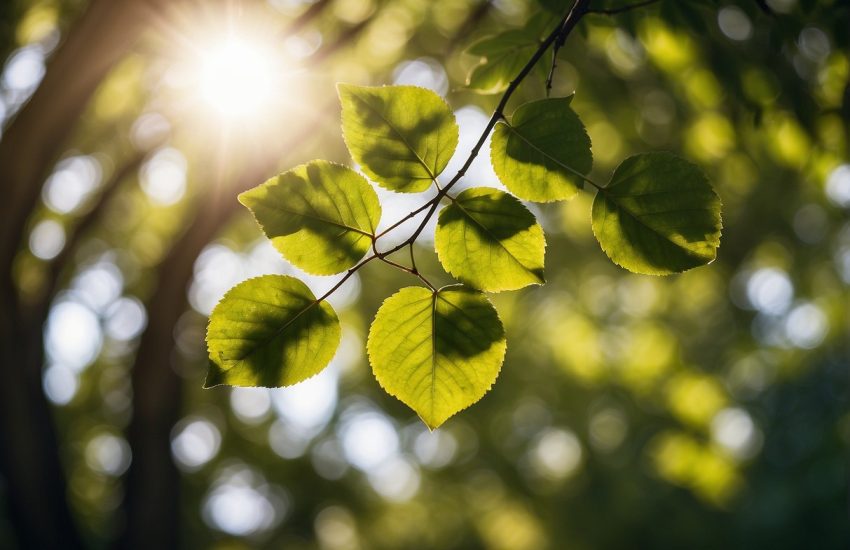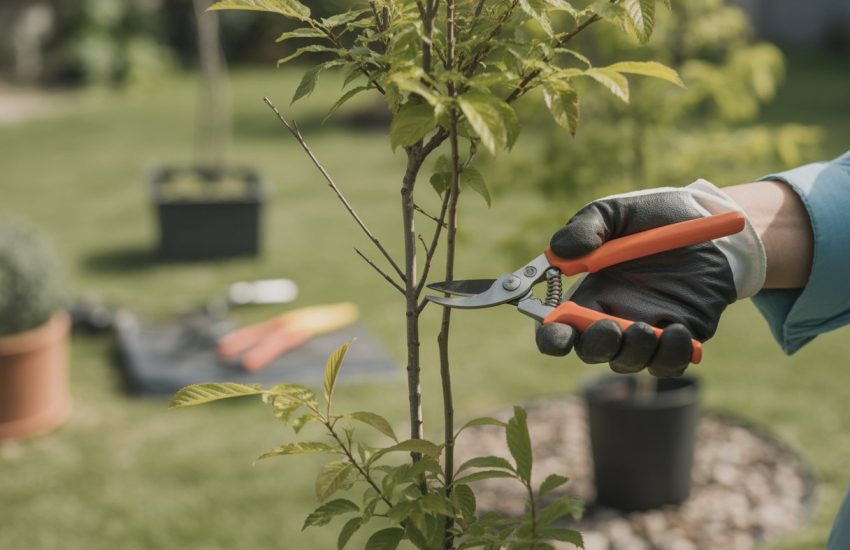Indoor Bonsai Tree Care: Tips and Tricks for Keeping Your Bonsai Healthy and Thriving
Indoor bonsai trees are a popular choice for those who want to bring a touch of nature into their homes. These miniature trees are not only aesthetically pleasing but also provide a sense of tranquility and calmness. However, taking care of indoor bonsai trees can be a challenging task, especially for beginners. In this article, we will discuss some essential tips to help you care for your indoor bonsai tree.

The first step in indoor bonsai tree care is to choose the right tree species. Some bonsai trees are better suited for indoor environments than others. For instance, tropical and subtropical species such as ficus, jade, and Chinese elm are ideal for indoor growing. These trees require minimal sunlight and can thrive in indoor temperatures. On the other hand, coniferous and deciduous species such as pine and maple require more sunlight and may not do well in indoor settings.
Once you have selected the right tree species, the next step is to ensure that your bonsai tree receives adequate sunlight. Most indoor bonsai trees require at least six hours of sunlight each day. If your tree is not receiving enough sunlight, you may need to supplement with artificial lighting. Additionally, you should also ensure that your tree is not placed near cold drafts or heating vents, as this can affect its growth and health. In the next section, we will discuss other essential tips for indoor bonsai tree care.
Choosing the Right Indoor Bonsai Tree
Indoor bonsai trees are a great way to bring a touch of nature into your home. However, choosing the right indoor bonsai tree can be a daunting task. In this section, we will discuss how to choose the right indoor bonsai tree for your home.
Popular Indoor Bonsai Species
There are several popular indoor bonsai species to choose from, including ficus, Fukien tea, jade, Chinese elm, carmona, Hawaiian umbrella, and schefflera. Each species has its own unique characteristics and requirements.
Ficus is a popular indoor bonsai tree species that is easy to care for and can tolerate a wide range of indoor environments. Fukien tea is another popular indoor bonsai tree species that is known for its small white flowers and shiny leaves. Jade is a popular indoor bonsai tree species that is known for its thick, succulent leaves and ease of care.
Chinese elm is a popular indoor bonsai tree species that is known for its elegant, flowing branches and small, serrated leaves. Carmona, also known as the Fukien tea, is a popular indoor bonsai tree species that is known for its small white flowers and dark green leaves. Hawaiian umbrella is a popular indoor bonsai tree species that is known for its umbrella-shaped canopy and small, glossy leaves. Schefflera is a popular indoor bonsai tree species that is known for its large, shiny leaves and ease of care.
Assessing Your Indoor Environment
When choosing an indoor bonsai tree, it is important to assess your indoor environment. Consider factors such as the amount of natural light your home receives, the temperature and humidity levels, and the amount of space you have available.
Some indoor bonsai trees, such as ficus and schefflera, can tolerate low light conditions, while others, such as jade and Chinese elm, require bright, indirect light. Temperature and humidity levels are also important factors to consider when choosing an indoor bonsai tree. Most indoor bonsai trees prefer temperatures between 60-75°F and humidity levels between 50-70%.
In conclusion, choosing the right indoor bonsai tree requires careful consideration of the species’ characteristics and your indoor environment. By taking the time to assess your indoor environment and selecting a species that suits your needs, you can enjoy the beauty and benefits of indoor bonsai trees in your home.
Fundamentals of Indoor Bonsai Care
Indoor bonsai trees can be a beautiful addition to any home or office, but they require proper care to thrive. Here are some fundamental aspects of indoor bonsai care that every owner should know.
Understanding Bonsai Soil
Bonsai trees require soil that is well-draining, yet retains enough moisture for the tree’s roots to absorb. A good bonsai soil mix includes a combination of organic and inorganic materials such as peat moss, perlite, and akadama. It’s important to repot your bonsai tree every two to three years to ensure that the soil remains fresh and healthy.
The Importance of Proper Lighting
Proper lighting is essential for the health of your indoor bonsai tree. Bonsai trees require bright, indirect sunlight or natural light to thrive. Direct sunlight can scorch the leaves and damage the tree. If your bonsai tree is not receiving enough light, you can supplement with a grow light.
Watering Your Bonsai Correctly
Watering your bonsai tree correctly is crucial. Overwatering can lead to root rot, while underwatering can cause the tree to dry out and die. To determine when your bonsai tree needs water, use a moisture meter to test the soil. Water your tree thoroughly, allowing the water to drain out of the pot and into a saucer. Empty the saucer after watering to prevent the roots from sitting in standing water.
Maintaining Humidity and Temperature
Bonsai trees thrive in environments with moderate humidity and temperatures. Use a humidity tray or place pebbles in a saucer with water to increase the humidity around your tree. Keep your bonsai tree in a room with a temperature between 60-75°F (15-24°C). Avoid placing your tree near drafts or heating/cooling vents.
By following these fundamental aspects of indoor bonsai care, you can ensure that your tree remains healthy and beautiful for years to come.
Advanced Bonsai Tree Techniques
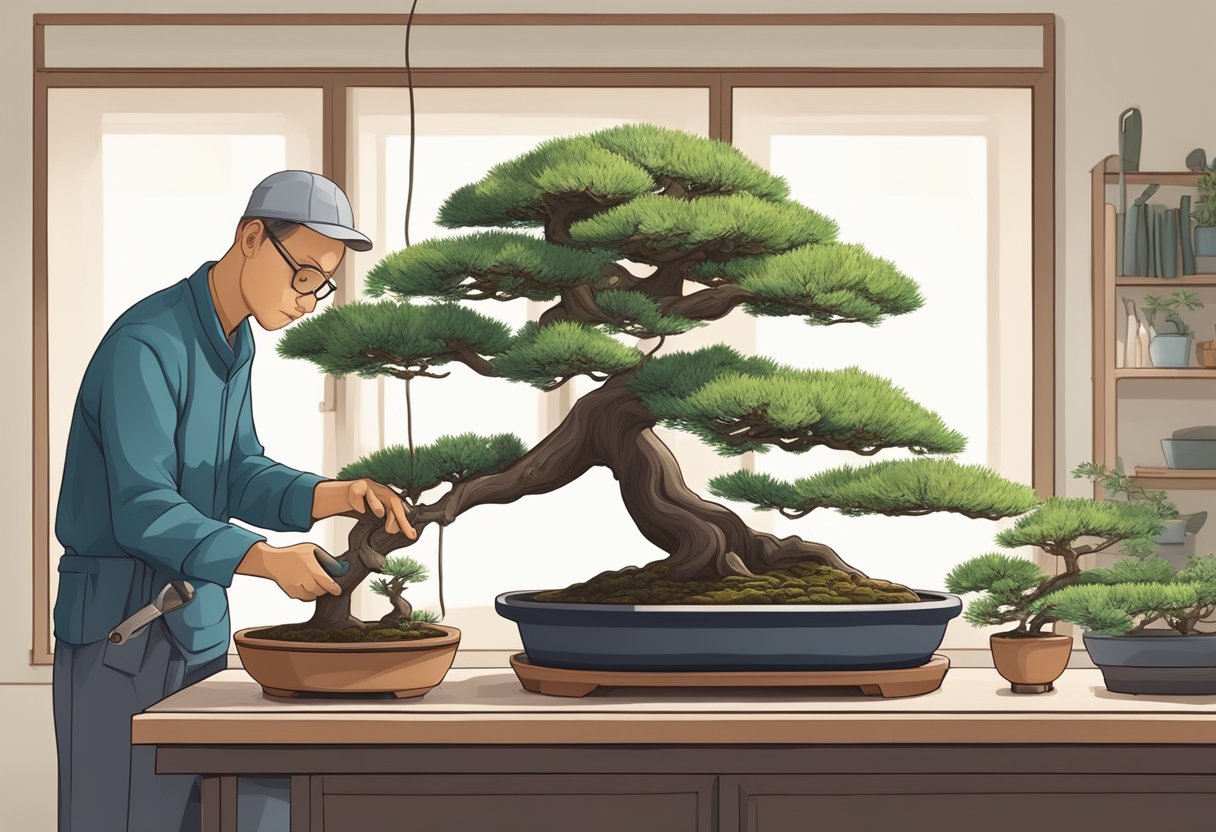
Pruning and Shaping
Pruning and shaping are essential techniques for maintaining the form and shape of your bonsai tree. Regular pruning helps to control the growth of the tree and maintain its desired shape. When pruning, it is important to make precise cuts to avoid damaging the tree. Use clean and sharp tools to make the cuts and avoid tearing the bark. Additionally, regular pruning helps to promote new growth and maintain the tree’s health.
Fertilizing and Feeding
Fertilizing and feeding are critical for the growth and health of your bonsai tree. Bonsai trees require a regular supply of nutrients to thrive. Use a balanced fertilizer that contains nitrogen, phosphorus, and potassium to provide your bonsai tree with the necessary nutrients. Also, consider feeding your bonsai tree with compost or other organic matter to improve soil quality and promote healthy growth.
Repotting and Root Care
Repotting and root care are essential techniques for maintaining the health and vitality of your bonsai tree. Repotting helps to refresh the soil and provide your bonsai tree with new nutrients. When repotting, it is important to prune the roots and remove any damaged or diseased roots. Additionally, consider using a specialized soil mix that is designed for bonsai trees to provide the necessary nutrients and promote healthy growth.
In summary, advanced bonsai techniques such as pruning and shaping, fertilizing and feeding, and repotting and root care are essential for maintaining the health and vitality of your bonsai tree. With regular maintenance and care, your bonsai tree will continue to thrive and provide years of enjoyment.
Seasonal Bonsai Tree Care
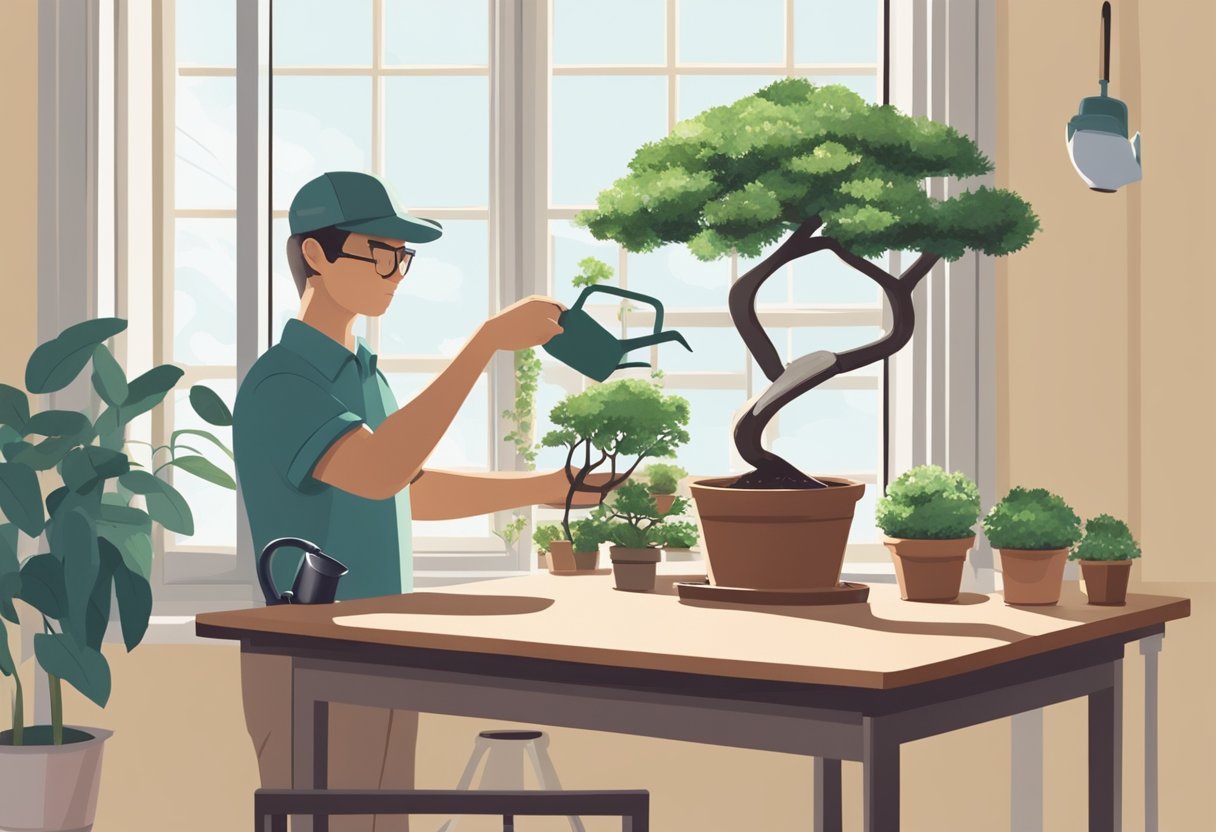
Bonsai trees require special care during different seasons to thrive. Proper seasonal care is essential to maintain the health and beauty of indoor bonsai trees. Here are some tips to help you manage your indoor bonsai trees during different seasons.
Managing Light and Water During Winter
During winter, lower light levels can affect the growth of indoor bonsai trees. It is important to provide sufficient light to your trees during this time. You can do this by placing your bonsai tree near a window that receives bright, indirect sunlight. If your tree is not getting enough light, you can supplement with artificial light.
Watering your bonsai tree during winter can be tricky. The lower light levels mean that your tree will need less water than it does during the growing season. You should water your tree only when the soil is dry to the touch. Overwatering can lead to root rot, which can be fatal to your tree.
Adjusting Care for Dormancy Periods
Bonsai trees go through a dormant period during the winter months. During this time, they require less water and nutrients. To help your tree through this period, you should reduce the frequency of watering and fertilizing. You can also reduce the amount of light your tree receives.
Temperate trees require a dormant period to rest and prepare for the growing season. During this time, they should be kept in a cool environment with lower light levels. Tropical and subtropical trees do not require a dormant period, but they may still experience a slower growth cycle during the winter months.
By adjusting your care for the dormant period, you can help your bonsai tree stay healthy and prepare for the next growing season. Proper seasonal adjustment is essential to maintain the health and beauty of your indoor bonsai trees.
Common Challenges in Indoor Bonsai Care
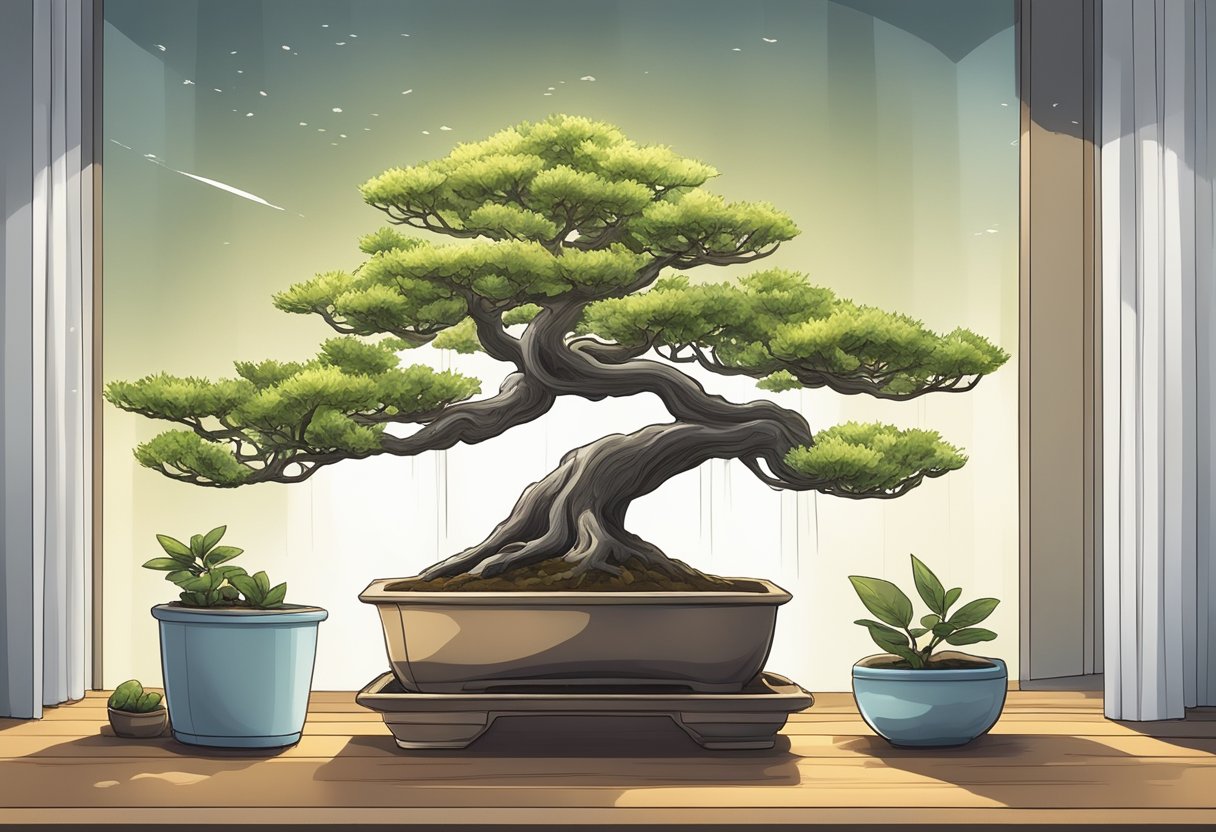
Indoor bonsai trees can be a beautiful addition to any home, but they require a bit of care and attention to thrive. Here are some common challenges that bonsai enthusiasts may face when caring for their indoor trees.
Dealing with Pests and Diseases
One of the biggest challenges in indoor bonsai care is dealing with pests and diseases. Bonsai trees are susceptible to a variety of pests, including spider mites, scale insects, and mealybugs. These pests can cause damage to the leaves and branches of the tree, and if left unchecked, can even kill the tree.
To prevent pests from infesting your bonsai tree, it is important to inspect your tree regularly and keep it clean. You can also use insecticidal soap or neem oil to treat any pests that you find.
In addition to pests, bonsai trees can also be susceptible to diseases such as root rot and fungal infections. To prevent these diseases, it is important to ensure that your bonsai tree is not over-watered and that it is planted in well-draining soil.
Addressing Environmental Stress
Indoor bonsai trees can also be affected by environmental stress. This can be caused by factors such as low humidity, improper lighting, and temperature fluctuations. When a bonsai tree is stressed, it can become more susceptible to pests and diseases.
To address environmental stress, it is important to create a suitable environment for your bonsai tree. This may involve placing the tree in a location with the proper lighting and humidity levels, or using a humidifier to increase the moisture in the air.
It is also important to be patient when caring for indoor bonsai trees. Bonsai trees require a lot of attention and care, and it may take some time to get the hang of caring for them properly. With time and practice, however, you can create a beautiful and healthy indoor bonsai tree.
Frequently Asked Questions
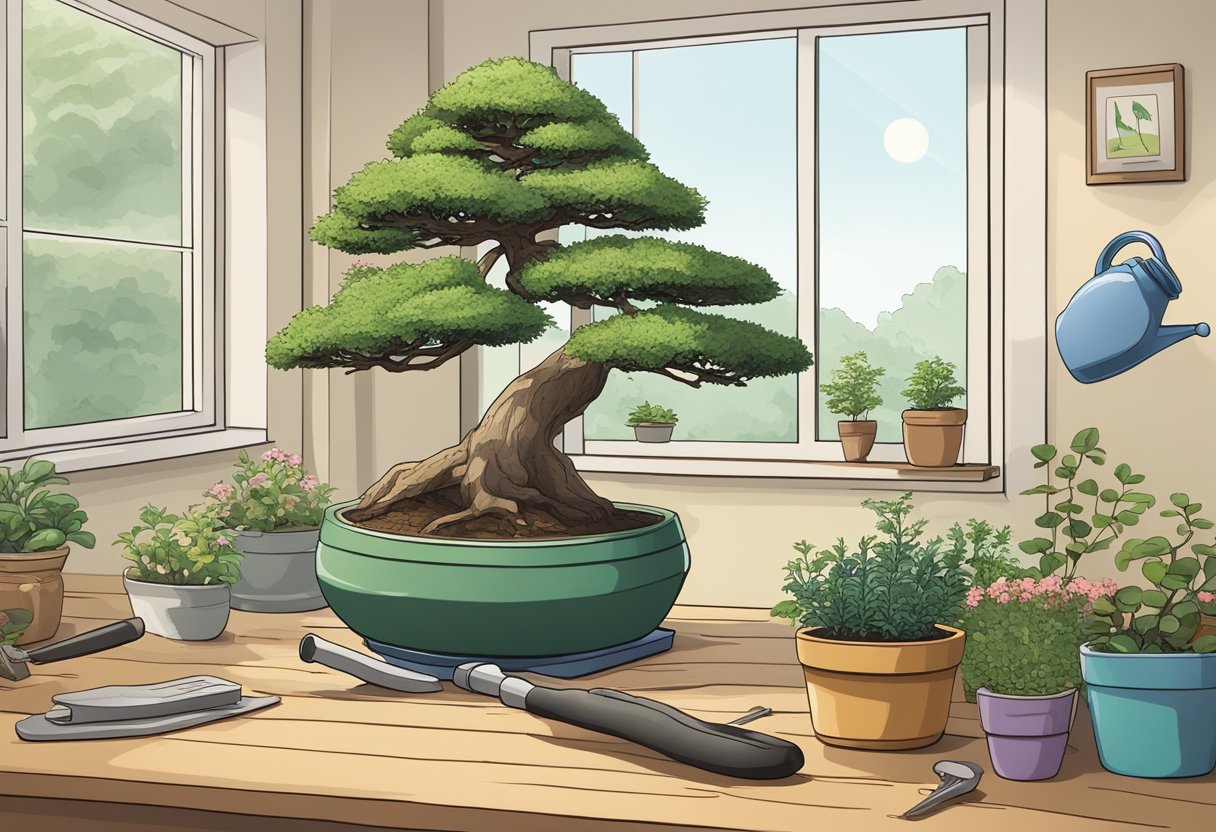
How do you properly water an indoor bonsai tree?
Watering an indoor bonsai tree is crucial for its survival. The best way to water a bonsai tree is to thoroughly soak the soil until water starts to drain from the bottom of the pot. It is important to avoid overwatering, as this can cause root rot. The frequency of watering will depend on the species of the bonsai tree, the size of the pot, and the environment it is in. It is recommended to check the soil regularly to determine when it needs watering.
What are the best practices for providing sunlight to an indoor bonsai?
Indoor bonsai trees require bright, indirect sunlight for optimal growth. It is important to avoid placing them in direct sunlight, as this can cause leaf burn. A south-facing window is usually the best location for an indoor bonsai tree, as it will receive the most sunlight. If natural light is not sufficient, artificial grow lights can be used to supplement.
Which species are suitable for indoor bonsai cultivation?
There are many species of trees that are suitable for indoor bonsai cultivation, including Ficus, Chinese Elm, and Jade. It is important to choose a species that is well-suited to indoor environments and can tolerate low light levels.
What are the essential care tips for beginners with indoor bonsai trees?
Beginners should start with a hardy species of bonsai tree, such as a Ficus or Chinese Elm. It is important to research the specific care requirements for the species of tree being grown. In general, bonsai trees require regular watering, fertilization, pruning, and repotting. It is important to avoid overwatering and to ensure that the tree receives enough sunlight.
How can you tell when your indoor bonsai tree needs more care?
There are several signs that an indoor bonsai tree may need more care, including yellowing or dropping leaves, lack of growth, and a dry or cracked soil surface. It is important to regularly inspect the tree for signs of stress and to adjust care accordingly.
What are the common challenges when maintaining an indoor bonsai and how to overcome them?
Common challenges when maintaining an indoor bonsai include overwatering, under-watering, pests, and diseases. To overcome these challenges, it is important to research the specific care requirements for the species of tree being grown and to monitor the tree regularly for signs of stress. Proper watering, fertilization, and pruning can help prevent many common issues. If pests or diseases are present, it is important to take immediate action to prevent further damage.

